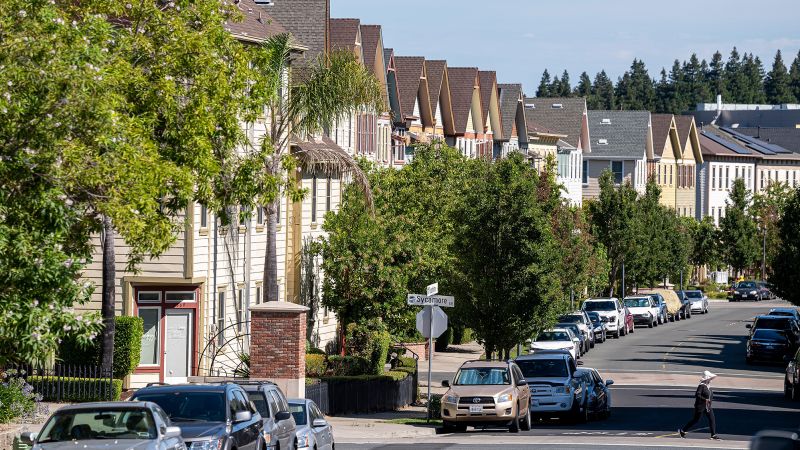Mortgage rates have surged, reaching the highest level since 2000, due to concerns about high interest rates and inflation lasting longer than anticipated, causing difficulties for potential homebuyers and exacerbating the supply shortage in the housing market.
Connecticut homebuyers are facing some of the highest mortgage rates in decades, with the average rate on a 30-year fixed mortgage reaching the highest level since 2000, driving up monthly costs and prompting buyers to consider different programs and grants, while lenders advise staying in the market and thinking about refinancing in the future.
Mortgage rates have risen for the fourth consecutive week, reaching their highest levels since 2000, leading to decreased demand for home-purchase mortgages and a stagnant housing market.
The interest rate on the most popular U.S. home loan reached its highest level since December 2000, leading to a significant drop in mortgage applications and contributing to the struggling housing market.
Mortgage rates in the US climbed to a 22-year high, surpassing 7%, which is posing significant challenges for first-time homebuyers and exacerbating the wealth gap between homeowners and renters.
The average interest rate for a 30-year fixed mortgage decreased, but the rate for a 15-year fixed mortgage increased, and there was a hike in the average rate for 5/1 adjustable-rate mortgages in the past seven days.
The average mortgage rate in the U.S. has surpassed 7% for the first time in over two decades, leaving homeowners feeling trapped by their low interest rates.
Mortgage rates have remained high despite bond yields and inflation being at average levels, largely due to the lack of refinancing activity and the longer duration of mortgage-backed securities, causing an unhealthy housing market.
Mortgage payments in the US are at their highest since the mid-1980s, making housing deeply unaffordable, but surprisingly, rising mortgage rates have not led to a decline in house prices as supply of properties has fallen almost in lockstep with demand and locked-in homeowners have invested more in fixing up their current homes, leading to a robust housing market despite the economic challenges.
Rates on 30-year fixed-rate mortgages rose Thursday following three straight days of declines, while most other loan types experienced small or moderate gains but still have a way to go before recovering from recent losses.
Average 30-year mortgage rates are still elevated at 6.94% in August, but they are expected to come down by the end of the year; however, a significant drop that will boost homebuying demand is not likely until 2024 or 2025, but there are advantages to buying a home even when rates are high, such as less competition.
Mortgage rates are expected to peak in the third quarter of 2023 before falling in the final months of the year, according to forecasts from Fannie Mae, the Mortgage Bankers Association, and the National Association of Realtors.
The high average rate for 30-year fixed-rate mortgages is deterring homeowners from selling, as they would face higher rates for a new mortgage and increased monthly payments, resulting in a shortage of homes for sale.
Mortgage rates for most types remained steady or experienced minimal changes, with the 30-year mortgage average dropping slightly, but still above its recent low, indicating that it's still a good idea to compare rates when seeking a mortgage.
Demand for mortgages in the US has hit a 28-year low, with purchase applications falling to the lowest level since December 1996, despite a decrease in mortgage rates.
The percentage of Americans paying $2,000 or more per month for a home mortgage has increased significantly in the past two years, with 51% of homebuyers facing these high payments in July 2023, compared to 18% in 2021, according to data from Black Knight. Additionally, nearly a quarter of homebuyers now have mortgage payments above $3,000, highlighting the unaffordability of the housing market for many Americans.
Mortgage rates have increased over the past week, with the average interest rates for 15-year fixed and 30-year fixed mortgages rising, while the average rate for 5/1 adjustable-rate mortgages declined; the Federal Reserve's efforts to control inflation by raising the federal funds rate may impact mortgage rates, but experts suggest that the markets have already factored in the increase.
US mortgage rates have decreased slightly for the second consecutive week, but they remain above 7%, causing home affordability to reach its lowest level in nearly four decades.
Mortgage rates are expected to trend down this year, although the exact timing is uncertain, with the Bureau of Labor Statistics' release of the latest Consumer Price Index data likely providing more insight, according to experts. Higher-than-expected inflation could keep rates elevated or even push them higher.
Mortgage payments in the US have reached a record high due to high mortgage rates and increasing home prices, causing pending home sales to decline by 12% year over year and pushing some buyers to the sidelines; however, sellers can still expect fair prices due to low inventory.
Long-term mortgage rates increased due to rising inflation and a strong economy, with 30-year fixed-rate mortgages at an average of 7.18%, according to the Freddie Mac survey.
Average mortgage rates have decreased for 15-year fixed, 30-year fixed, and 5/1 adjustable-rate mortgages, although they remain above 7%, and experts predict that the Federal Reserve will refrain from raising rates in its September meeting.
Mortgage rates are currently high but may level off soon, with experts predicting a potential decrease in early 2024 and rates around 5% in Q4, according to industry professionals.
US mortgage rates remain above 7% for the sixth consecutive week as inflation pressures persist, leading to cooling housing demand and a decline in builder sentiment, according to Freddie Mac's chief economist.
The Federal Reserve's aggressive rate-hiking campaign has led to higher borrowing rates for consumers, with the average interest rate for a 30-year fixed-rate mortgage reaching a two-decade high of 7.18% and credit card interest rates exceeding 20%.
The average long-term U.S. mortgage rate has increased, posing challenges for homebuyers in an already unaffordable housing market.
